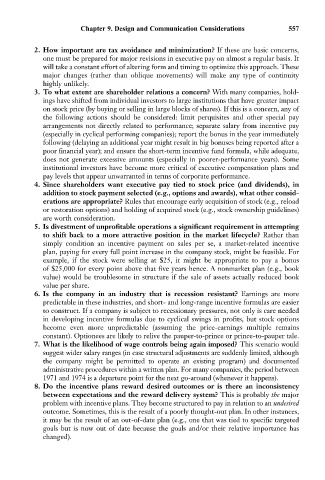Page 571 - Bruce Ellig - The Complete Guide to Executive Compensation (2007)
P. 571
Chapter 9. Design and Communication Considerations 557
2. How important are tax avoidance and minimization? If these are basic concerns,
one must be prepared for major revisions in executive pay on almost a regular basis. It
will take a constant effort of altering form and timing to optimize this approach. These
major changes (rather than oblique movements) will make any type of continuity
highly unlikely.
3. To what extent are shareholder relations a concern? With many companies, hold-
ings have shifted from individual investors to large institutions that have greater impact
on stock price (by buying or selling in large blocks of shares). If this is a concern, any of
the following actions should be considered: limit perquisites and other special pay
arrangements not directly related to performance; separate salary from incentive pay
(especially in cyclical performing companies); report the bonus in the year immediately
following (delaying an additional year might result in big bonuses being reported after a
poor financial year); and ensure the short-term incentive fund formula, while adequate,
does not generate excessive amounts (especially in poorer-performance years). Some
institutional investors have become more critical of executive compensation plans and
pay levels that appear unwarranted in terms of corporate performance.
4. Since shareholders want executive pay tied to stock price (and dividends), in
addition to stock payment selected (e.g., options and awards), what other consid-
erations are appropriate? Rules that encourage early acquisition of stock (e.g., reload
or restoration options) and holding of acquired stock (e.g., stock ownership guidelines)
are worth consideration.
5. Is divestment of unprofitable operations a significant requirement in attempting
to shift back to a more attractive position in the market lifecycle? Rather than
simply condition an incentive payment on sales per se, a market-related incentive
plan, paying for every full point increase in the company stock, might be feasible. For
example, if the stock were selling at $25, it might be appropriate to pay a bonus
of $25,000 for every point above that five years hence. A nonmarket plan (e.g., book
value) would be troublesome in structure if the sale of assets actually reduced book
value per share.
6. Is the company in an industry that is recession resistant? Earnings are more
predictable in these industries, and short- and long-range incentive formulas are easier
to construct. If a company is subject to recessionary pressures, not only is care needed
in developing incentive formulas due to cyclical swings in profits, but stock options
become even more unpredictable (assuming the price-earnings multiple remains
constant). Optionees are likely to relive the pauper-to-prince or prince-to-pauper tale.
7. What is the likelihood of wage controls being again imposed? This scenario would
suggest wider salary ranges (in case structural adjustments are suddenly limited, although
the company might be permitted to operate an existing program) and documented
administrative procedures within a written plan. For many companies, the period between
1971 and 1974 is a departure point for the next go-around (whenever it happens).
8. Do the incentive plans reward desired outcomes or is there an inconsistency
between expectations and the reward delivery system? This is probably the major
problem with incentive plans. They become structured to pay in relation to an undesired
outcome. Sometimes, this is the result of a poorly thought-out plan. In other instances,
it may be the result of an out-of-date plan (e.g., one that was tied to specific targeted
goals but is now out of date because the goals and/or their relative importance has
changed).

